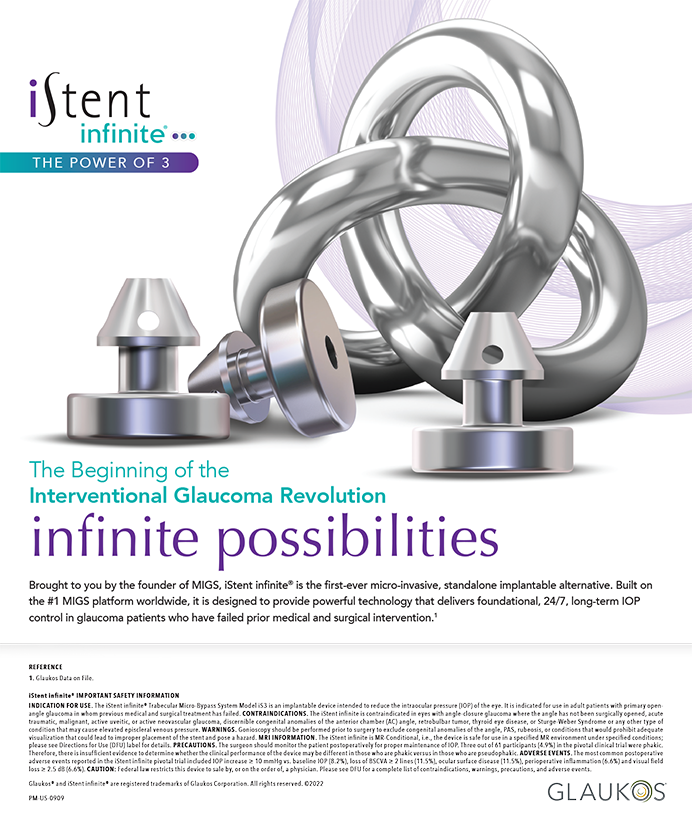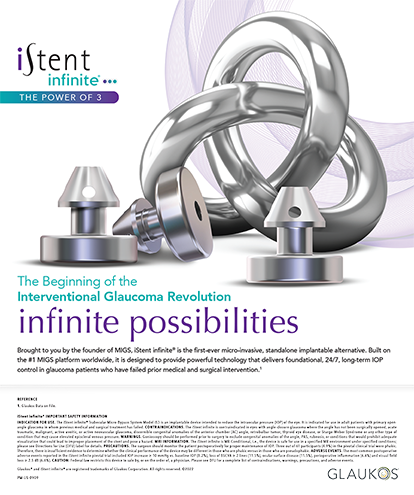More and more applications of nanotechnology to medical science are being developed, particularly in the area of targeted drug delivery. The FDA has approved several liposomes, or small particles, for the treatment of ovarian cancer, and phase 2 trials are underway for therapies to be used against non-small cell lung cancer and prostate cancer. By definition, nanotechnology is the understanding and control of matter at dimensions between approximately 1 and 100 nm, where unique phenomena enable novel applications.1 When a nanoparticle is decorated with the right substances, scientists have found that it can be delivered to cells in a more targeted way and can penetrate more deeply, thus enabling innovative functions.
NANOTECHNOLOGY AND MUCUS
Targeted drug delivery via nanotechnology is also being applied to the field of ophthalmology. Mucus serves as a primary defense mechanism in the body. A heterogeneous mesh of mucin fibers protects the body against pathogens and other foreign material by excluding particles larger than pores and binding to foreign particles via alveolated macromolecules in the mucus network. Particles trapped in the surface mucus layer of the tear film are cleared away with blinking, which occurs approximately every second. Unfortunately, this superbly designed protective mechanism also greatly limits the delivery and therapeutic efficacy of topical ocular drugs.
The penetration and retention of ocular drugs can now be significantly increased, thanks to a breakthrough in nanotechnology. A decade of work by Justin Hanes, PhD, at John Hopkins University has resulted in mucus penetrating particles (MPPs), which combine nanometric particle size and proprietary surface engineering to create particles that can freely diffuse through the mucus layer of the tear film. Scientists at Kala Pharmaceuticals are leveraging this technology to advance a diversified pipeline of transformative, topically applied products for a range of ophthalmic diseases such as postsurgical ocular inflammation, dry eye disease, retinal vein occlusion, diabetic macular edema, and wet age-related macular degeneration (AMD).
Kala’s engineering process features the creation of a nanoparticle crystalline core that consists of the therapeutic agent surrounded by surface-engineered polymers, which allow the drug to be inert to the mucin fibers. As a result, therapeutic agents avoid being trapped by the tear film and cleared via blinking, which extends their duration of action and enhances their penetration to the site of disease.
EARLY DATA
Data released at the 2014 American Society of Cataract and Refractive Surgery Annual Meeting showed that well-known drugs such as loteprednol etabonate ophthalmic suspension (Lotemax; Bausch + Lomb) can be more effective when combined with Kala’s MPP technology. Investigators compared Lotemax to a nanosuspension of loteprednol etabonate 0.4% that was formulated with a proprietary coating (LE-MPP) to allow the drug to penetrate the mucus fibers of the tear film in a study that included 156 rabbit eyes.2 After a single drop, peak concentrations of loteprednol in the cornea and aqueous humor were 1,470 ng/g and 12.7 ng/mL for the Lotemax gel versus 2,580 ng/g and 30.3 ng/mL for LE-MPP. Even at a 20% lower dose strength, LE-MPP provided higher drug levels than the gel formulation.
MPP technology may also be beneficial in posterior segment diseases such as AMD. A pharmacodynamic evaluation of topically administered axitinib (Inlyta; Pfizer), a small-molecule receptor tyrosine kinase inhibitor or RTKi formulated as MPP, was performed in pigmented and nonpigmented rabbits.3 Topical delivery of the agent formulated as MPP greatly enhanced drug levels in the retina, suggesting its potential for the treatment of AMD. The data also validated the potential of MPP technology for creating highly effective topical treatments for a broad range of ocular diseases.
THE PIPELINE
Kala is building a pipeline of diverse, innovative products that rapidly and effectively penetrate the mucus barrier to treat ocular diseases. The company is now advancing treatments for five ocular diseases; four of these agents will begin clinical development early next year. The company expects LE-MPP for postoperative ocular inflammation and pain to enter a pivotal phase 2b trial later this year and to complete a second phase 3 trial in 2015. Also this year, Kala will initiate US clinical trials of 0.25% LE-MPP for the treatment of patients with dry eye and meibomian gland disease.
Parallel studies are testing the ability of topical agents to deliver drugs to the back of the eye. A research-phase program featuring a topical RTKi-MPP for the treatment of wet AMD is advancing toward selection of a clinical candidate this year, and the company expects an investigational new drug submission in 2015. According to Kala, the results could open a vast array of possible therapies for diabetic macular edema and cystoid macular edema as well.
CONCLUSION
Continued studies could provide breakthrough treatment for ocular diseases, and nanotechnology has potential applications in respiratory diseases, women’s reproductive health, and gastrointestinal diseases.
Adrianne Resek, MA, is a freelance medical writer whose clients include Pascale Communications, which represents Kala.
- National Nanotechnology Initiative. What it is and how it works. http://www.nano.gov/nanotech-101/what Accessed May 15, 2014.
- Brazzell K, Schopf L, Enlow E, et al. Evaluation of the pharmacokinetic profile of a novel ophthalmic formulation of loteprednol etabonate. Paper presented at: The American Society of Cataract and Refractive Surgery/ASOA Symposium and Congress; April 25, 2014; Boston, MA.
- Schopf L, Enlow E, Popov A, et al. Enhanced topical delivery of a small molecule receptor tyrosine kinase inhibitor (RTKi) via mucosal-penetrating particle technology. Poster presented at: Association for Research Vision in Ophthalmology 2013; May 5, 2013; Orlando, FL.


